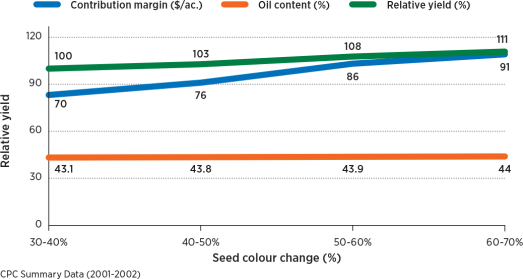Top science for the bottom line
The canola industry contributes more to the Canadian economy than any other grain or oilseed crop, and research investment through a long-term science strategy provides innovation that will expand its potential. Canola agronomic research is supported by the industry through the provincial canola grower organizations, the Canola Council of Canada and government-backed research partnerships, with studies focused on increasing yield and profitability for growers, reducing production risk and enhancing sustainability.
The 2017 Science Edition of Canola Digest released in November highlights the excellent return that well-spent research investment of levy dollars provides and how that investment opens up other sources for funding. The grower experiences featured in this issue, alongside summaries of recently completed and ongoing projects, demonstrates how research pays dividends to the canola growers of Western Canada.
The science behind these specific grower stories can be found in the summaries, full project reports and video interviews available on the Canola Research Hub at canolaresearch.ca. Here are some recent findings that help build on over three decades of research and provide best-practice recommendations for today’s canola varieties.
“Knowledge gained through local fertility trials has helped us make better fertilizer-rate decisions, which have made a big difference to the bottom line for our farm.”
Fertilizer recommendations from soil testing
One such study, led by Kabal Gill of Smoky Applied Research & Demonstration Association (SARDA), found that soil-test-based fertilizer applications can be a sustainable and economical technique to optimize crop production and profit margin in both direct-seeding and conventional tillage systems.
This study investigated the effects of different fertilizer rates and seeding systems (direct seeding and conventional tillage, individually and in combination) over six growing seasons. Fertilizer rates were tested at 0, 60, 100 and 140 per cent of the recommendation in a canola-cereal (wheat or barley) rotation, based on annual soil tests for depths of 0-6” and 6-12”. The amounts of nitrogen, phosphorus, potassium and sulphur nutrients were calculated for each treatment.
Soil-test-based fertilizer applications aren’t always used due to questions of their effectiveness. Gill’s results suggest that these recommendations are reliable, and nutrient availability from Plant Root Simulator soil probes supported the accuracy of soil test results. A fertilizer rate near 100 per cent of the recommendation was able to achieve optimum canola yield.
| Source: SARDA *LSD is least significant difference at 5% probability. | |||||
| Treatment | 2011 | 2012 | 2013 | 2014 | 2015 |
|---|---|---|---|---|---|
| Mean 0% | 3.19 | 1.41 | 1.42 | 0.83 | 1.04 |
| Mean 60% | 4.08 | 2.56 | 3.34 | 1.58 | 3.01 |
| Mean 100% | 4.02 | 3.02 | 3.73 | 1.79 | 3.14 |
| Mean 140% | 4.31 | 3.30 | 4.27 | 1.83 | 3.39 |
| *LSD | 0.31 | 0.178 | 0.46 | 0.166 | 0.341 |
“One bit of farmer-funded science that has made us a lot of money is work to show how later swathing and, in some cases, straight combining can produce higher yields.”
Later swathing or straight combining for higher yield
With growers taking on more acres than ever, the time crunch at harvest can make it tempting to begin swathing early. But the yield gain and improved quality resulting from allowing additional time for colour change can make it well worth the wait. These findings were first published in the CCC’s Crop Production Centre summary reports from 2001 and 2002 and have been supported by subsequent literature.
A 12-site-year study from locations across the Prairies and one site in B.C. determined that the highest-yielding swathed crops were cut at either 50 to 60 per cent seed colour change (SCC) or 60 to 70 per cent SCC on the main stem. By swathing progressively later (up to a maximum of 60 to 70 per cent SCC), canola fields also produced higher seed weights, greater oil content, lower green seed percentage and a higher grade.
Later studies also determined that yield loss and swath timing were strongly related. The lowest losses were associated with swath timing as late as 60 to 80 per cent ‘brown seed’ and the highest losses recorded at 10 to 20 per cent (Brown et al, 1999). Harvesting canola when seeds were brown to black also resulted in higher seed quality for growers producing seed canola (Elias and Copeland, 2001).
An extensive study of Western Canadian canola samples confirmed that yield and oil content were positively correlated (Daun, 2006) and that the increased duration required for higher-yielding crops to mature also provides the time needed for chlorophyll levels to decrease to an optimal level. This is supported by findings that per cent green seed is significantly higher in early-harvest canola and seedpod shatter losses are greater in later-harvested canola (Watson et al, 2008).
With current hybrid varieties and lower target plant populations that result in more yield from side branches, later swath timing is even more crucial. Of course, every year won’t necessarily allow for ideal conditions, but waiting even a few extra days to swath will reduce average quality losses and increase yields for the farm. For more information, check out the CCC swathing guide at canolacouncil.org/links/swath.
Time of swathing trials (12 site years)

Researchers have also worked to determine if the risks from straight-combining of canola are offset by increased yield potential, based on producer experience. In the Canola Harvest Management Study led by Paul Watson of Alberta Research Council under the provincial grower groups’ Canola Agronomic Research Program, treatments included low and high crop density, low and high fertility, early and late weed removal and early and late harvest time. These factors were selected to evaluate the relationship between potential yield and shatter loss.
Watson’s results conclude that straight cutting canola is a viable option for producers. Averaged across all sites and locations, the top five straight-cut treatments consistently provided equal or better yields when compared to the optimal swath check. The most important factor for improving yield was increased fertility, and the probability for success is increased by following best management practices for stand establishment, crop nutrition and pest management.
Another study led by Chris Holzapfel of Indian Head Agricultural Research Foundation (IHARF) found that some varieties are better suited to straight combining than others and that success largely depends on environmental factors and timeliness of harvest. This four-year, multi-site study examined yield losses due to pod shatter and pod drop at optimal and delayed harvest dates.
While varieties showed differences in resistance to pod drop and pod shatter, environmental conditions often had a greater impact on the quantity of yield losses. These findings may have been impacted by the varying days to maturity for each variety, ranging from 90 to 106 days across all varieties tested.
Timing of harvest affected total yield reductions, as expected. Varieties harvested when ready had losses of less than five per cent, compared to the sites harvested three to four weeks later with an average yield reduction of 15 per cent across all site years and varieties. Holzapfel determined that 25 to 50 per cent of these yield losses were generally the result of pod dropping as opposed to pod shattering.
As long as harvest wasn’t delayed too much, this study found that losses from straight combining shouldn’t be significant under normal environmental conditions. Pre-season selection of shatter-tolerant varieties should still include consideration for yield potential, days to maturity and herbicide system rotation, and growers should strive to complete harvest as soon as possible after the crop is fit to combine to minimize losses.
You can find summaries, reports and interactive data from this research, and other completed and in-progress studies, on the Hub at canolaresearch.ca.






